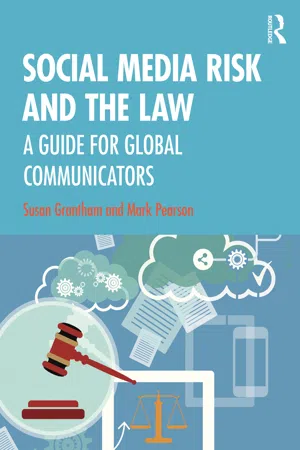
Social Media Risk and the Law
A Guide for Global Communicators
Susan Grantham, Mark Pearson
- 176 pages
- English
- ePUB (adapté aux mobiles)
- Disponible sur iOS et Android
Social Media Risk and the Law
A Guide for Global Communicators
Susan Grantham, Mark Pearson
À propos de ce livre
Social media has many advantages for professional communication – but it also carries considerable risks, including legal pitfalls. This book equips students and communication professionals with the knowledge and skills to help minimise the risks that can arise when they post or host on social media. It offers them strategies for taking advantage of the opportunities of social media while also navigating the ethical, legal, and organisational risks that can lead to audience outrage, brand damage, expensive litigation and communication crises. The book uses stakeholder theory and risk analysis tools to anticipate, identify, address and balance these opportunities and risks. It takes a global approach to risk and social media law, drawing on fascinating case studies from key international jurisdictions to explain and illustrate the basic principles. Whether you are a corporate communicator, social media manager, journalist, marketer, blogger or student you will find this book an essential addition to your professional library as the first reference point when social media and legal risks arise.
Foire aux questions
Informations
Part 1
Social media law and risk management
Introduction and context
1
Introduction – defining the boundaries of the theory and practice of social media risk
Glossary
Abstract
- Introduction
- The changing landscape
- Case study 1.1 – Indian Ocean tsunami
- Case study 1.2 – Christchurch terror attack
- Case study 1.3 – Footballer’s post case : Folau v. Rugby Australia
- Understanding risk: ethical, legal and organisational
- Theoretical underpinnings
- Discussion questions and project topics
- Practice tips
- Cases cited
- References
Introduction
The changing landscape
- 1979 – UseNet. Early stages of a networked society through a virtual newsletter. It is now one of the oldest online communication examples still in use.
- 1988 – Internet Relay Chats (IRC). Designed by a Finnish IT professional, it was the first chat network. It was designed to allow group communication on discussion boards by transferring data between servers.
- 1994 – First blog – Live.net. Created by Justin Hall, it is considered the first blog site that started as a web-based diary. In 2021 it is estimated that one-third of all websites worldwide are blogs.
- 1997 – SixDegrees. The first example of social media, SixDegrees was popular between 1997 and 2001. At its height it had 3.5 million members.
- 2003 – LinkedIn. In its first year the site had 1 million professionals sign up to use it. By 2021, the number of monthly users had risen to 722 million, with more than 55 million companies having LinkedIn pages.
- 2003 – WordPress. Set up as a content management system available to everyone, WordPress now hosts more than one-third of websites on the Internet and is a ubiquitous host for blogs.
- 2004 – Facebook. Approximately 1 million users were recorded in its first year. By 2021 the site recorded 2.74 billion active monthly users and 90 million small business users.
- 2005 – YouTube. In its first year, YouTube had huge success including an uploaded video that received more than 1 million views. Most recent statistics show that YouTube has 2.3 billion active monthly users uploading, sharing and viewing content.
- 2006 – Twitter. There are now more than 353 million users on Twitter with 500 million tweets being sent each day, including world-changing tweets by then US president Donald Trump in the 2017–2021 period.
- 2007 – The hashtag. Now a powerful distribution strategy, the hashtag is what brings the social media community together on topics of interest and allows topics to ‘trend’ across platforms. It has been the core of significant social movements including #metoo and #blacklivesmatter.
- 2009 – Large companies and governments started using social media to communicate directly with audiences in an easy and cost-effective way.
- 2010 – Instagram. One of the first mainstream social media platforms that focussed on images, 25,000 people signed up to use Instagram on its first day and it reached 1 million users within three months. By 2021 it recorded more than 1 billion users.
- 2011 – Snapchat. In 2021 this platform had close to 400 million active monthly users and in excess of 1 billion ‘snaps’ (time-limited multimedia posts) per day.
- 2016 – TikTok. Originally released as Douyin, it was launched as TikTok in 2017 as a video-sharing platform that allows users to share 15-second videos accompanied by a soundtrack. By 2021 there were 689 million monthly users of this platform.
- 2016/2017 – Livefeed video and ‘stories’ added to mainstream social media platforms. This revolutionised the way organisations communicated with audiences and allowed for events, such as press conferences, to be livestreamed for all to witness. In 2021, both Facebook and Instagram recorded more than 500 million accounts using ‘stories’ each day.